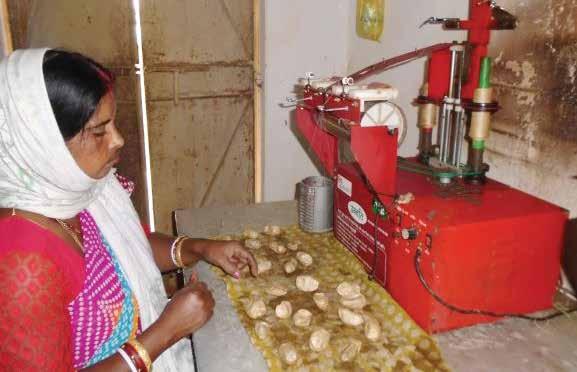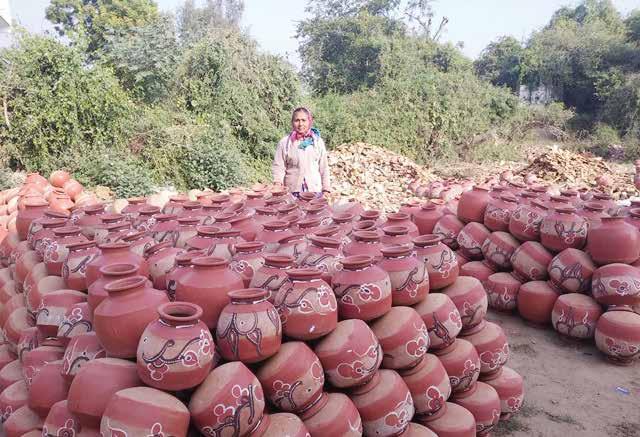
5 minute read
TABLE 11: Solar potential in the studied clusters in Jharkhand
provided in Table 11. This information would be relevant for the solar suppliers or developers at the state or national level who might assess their business potential if they intervene in the identified clusters.
TABLE 11: Solar potential in the studied clusters in Jharkhand Cluster District Total number of units Daily electricity consumption (kWh)/unit Solar capacity for individual units (kWp) Total solar potential in the cluster (kWp)
Advertisement
Maganpur Tailoring Cluster Ramgarh Small 100 Medium 200 Large 50 Small 0.71 kW
Medium – 1.42 kW Large 2.12 kW Small 0.15 kW
Medium 0.3 kW Large 0.45 kW 98
Kharsawan Silk Reeling Cluster
Bishnugarh Brass Cluster Seraikela Kharsawan
Hazaribagh 30 5.232 kW 2.2 kW 66
Small 35 Medium 150 Large 35 Small 3.074 kW
Medium 9.096 kW
Large 12.08 kW Small 1.0 kW
Medium 2.0 kW
Large 5.0 kW 500
46 Study the Feasibility and Potential of Solar Applications in Micro, Small and Medium Enterprises in Rural India
5. Conclusion
MSMEs are a thriving entity in the Indian industrial ecosystem, gainfully providing livelihoods to millions of people. Micro/home-based industries, which cover around 99% of the MSME landscape, not only engage many enterprises that are based in the vicinities of people’s homes but also bear witness to innumerable heritage works that have been passed down through generations with skills possessed only by a few. However, the unique enterprises of the micro-enterprises sector, which often represents the distinct culture of different geographically diverse peoples, face several threats. Access to credit, infrastructure, institutional support, among others, are some of the many issues faced by micro/homebased enterprises. With markets opening up globally, many of these enterprises struggle with competition. Moreover, micro-enterprises, being less organized and scattered, often operating individually, lag in terms of availing the benefits of the numerous schemes and initiatives launched by the government for their development. In relation to infrastructure, access to electricity at cheaper cost is an important prerequisite for seamless production and competitiveness wherever mechanization has taken place. In some states where power supply situation is satisfactory, the state government provides subsidy to a few clusters to make the enterprises competitive. Still a substantial cost of electricity is being borne by the enterprise owners themselves. In states where unreliable supply of electricity affects production, many enterprises use fossil fuels for power backup, leading to high costs of production and carbon emissions.
Most of the studied clusters are traditional and popular in their respective states. In fact, the salt cluster of Kutch and wooden toy cluster of Channapatna are nationally well known. Clusters, namely wooden toy, silk thread twisting, and powerloom clusters of Karnataka, and silk reeling and brassware clusters of Jharkhand are already registered under different schemes of the Ministry of MSME for possible assistance. The present study has undertaken extensive survey in the nine micro-enterprise clusters to understand their energy requirements and potential for solar application. Each cluster is unique and has distinct set of challenges. The following major findings were observed during the study: » Three (03) enterprise clusters of Jharkhand were surveyed, one each from Hazaribag, Ramgarh, and Sareikela-Kharsawan districts (all aspirational districts). Electricity supply has been found unreliable and intermittent and available only for 8–10 hours daily. In Bishnugarh brass cluster of Hazaribag, the enterprises are heavily reliant on diesel run gen-sets and reluctant to apply commercial connection due to high initial deposit and monthly tariff (Onetime deposit of INR 12,000 for every 1 HP load and more than INR 6 per unit). Access to interrupted and affordable electricity would surely replace diesel use and reduce cost of production. In Maganpur sewing cluster of Ramgarh, the entrepreneurs have to depend upon manual stitching for 3 to 4 hours daily. Access to solar power can enhance the working hours by 4 to 5 hours daily, and hence has the potential to increase production and income by around 30–40%. In Sareikela–Kharsawan district, the silk reeling units at common facilitation centres of JHARCRAFT, presently deprived of grid electricity, urgently need solar power
and can enhance further mechanization to create more employment, production, and income of the women artisans.
» Four (04) enterprise clusters were surveyed in Karnataka, one each from Chikkaballapura, Belagavi, Kolar, and Ramanagara districts. Uninterrupted power supply, for almost 22–24 hours daily, has been found in all these clusters. The state Department of Handloom and Textiles (DoHT) has been providing 60% tariff subsidy to the entrepreneurs of Khasbag powerloom and Sidlaghatta silk twisting cluster. Surprisingly, the entrepreneurs of all these clusters, including Channapatna wooden toy and Shivarapatna stone idol clusters, have wished for solar power system if made available at subsidized price. » In Gujarat, the pottery clusters of Gandhinagar and Kutch districts are hardly facing any power issues. However, a shift to clean energy is expected to help in reducing their electricity bills and improve profitability. Electricity infrastructure is, however, absent in the salt clusters of Kutch, Sundernagar, and Patan districts of the state and holds huge scope for decentralized solar PV applications. The state government has also earmarked specific budget provision (2020–21) for purchasing solar pumps for the salt workers.
» Most of these enterprises have been facing many challenges including lack of raw materials, inadequate working capital, lack of investment capacity for advanced tools and equipment, expensive yet unreliable energy sources, etc. Hence, they lack the ability to invest upfront for solar PV as well. Small and affordable loans are not easily available from local commercial banks and financing institutions. Lack of awareness and sensitizations on solar potential have also led to little or no dissemination. The present national- and state-level MSME and solar policies encourage the use of non-conventional energy sources including solar in manufacturing sector, however lack of implementing guidelines discourage financing of solar PV system in the sector except silk sector scheme of Ministry of Textile, Govt. of India.
» The primary survey has enabled in the design of appropriately sized solar PV system across the clusters and enterprises. While the smallest solar PV size is needed in Maganpur sewing cluster (as small as 150 Wp) of Jharkhand, the biggest solar PV size is needed in Chhannapatna wooden toy cluster (as big as 14 kWp) of Karnataka. Similarly, the aggregate solar potential has been highest in salt cluster and lowest in pottery cluster of Gujarat. All four clusters of Karnataka and salt cluster of Gujarat have significantly higher solar PV potential.
» The business models developed across the clusters and enterprises reveal the payback period of solar PV investment in Jharkhand is minimum (1 to 3 years) with zero subsidy which is exception to all clusters of Karnataka and Gujarat where subsidy to tune of 40% to 65% is needed to keep payback period in and around 5 years period with same bank interest rate (8% per annum).
A brief summary of the solar potential and business feasibility of the studied clusters is provided in Table 12.




